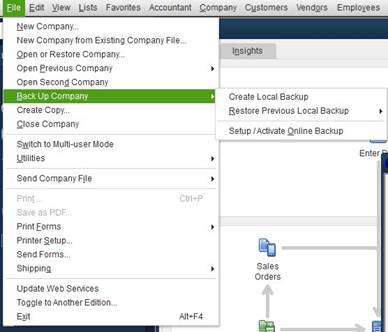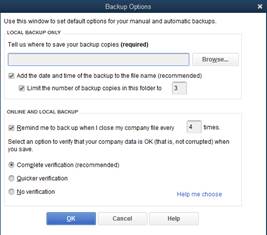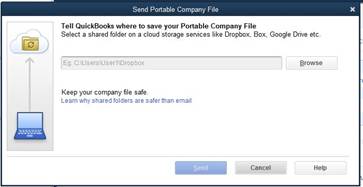There is a lot of confusion among both clients and accountants about the myriad of ways a client can get their QuickBooks (QB) files into their accountant’s hands. Here is a rundown of options and their pros & cons.
NOTE: For all types of files, please use a secure way to get them to your accountant. This also applies to passwords.
QuickBooks Desktop:
Method #1:
A Backup QB File: This is a complete back up of your files that can be restored by your accountant, including logos, invoice templates, etc.
Pros:
- If your computer crashes, everything prior to the date of creating the backup can be restored in its entirety. (Best practice is to create regular QB File backups in case the computer, where your QuickBooks resides, crashes. These backups should be on a separate computer or external device, never on the same computer as the original program.)
- Once the backup is sent, you can continue to work in QuickBooks as you normally would.
- There is no need to retrieve the backup file from the accountant.
- Any work the accountant does will not affect your QuickBooks.
- Check with your accountant to see if they provide a secure method for transferring large files, for instance, a client portal.
Cons:
- It is a large file so it can be more difficult to send to your accountant.
- Secure Email attachments (link provided by your accountant) will not accommodate the large size of backup files.
- Regular email attachment:
◦ Is not secure.
◦ Backup file will be too big. - Thumb drive or external hard drive:
◦ Size is not an issue.
◦ Requires physical drop off to the accountant, (Challenging due to COVID-19 and social distancing.)
◦ There is a risk of loss. - If the accountant does any work on the backup copy:
◦ This work will not be in your books.
◦ The work will need to be duplicated by you, in your books, based on the accountant’s recommendations.
How to create a backup (Remember to provide an updated password for your accountant, securely.)
1. From the File drop down menu:
a. Hover over: “Back Up Company”

b. Click on: “Create Local Backup”
2. Pop-up Window: Confirms “Local backup” chosen. Click “Next”

3. Pop-up Window (Backup Options) provides a file location window/browse button for you to choose where to save your file.
a. Save it directly to your accountant’s portal, if available.
b. Save it locally where you know you can find it to send the file securely to your accountant. (Ask your accountant how they prefer secure files to be sent.)
c. Save it to an external hard drive or thumb drive to be physically transported to your accountant
4. There is a lot going on in the Backup Options Pop-up Window:
a. For the purposes of getting a back up to your accountant:
i. Uncheck all boxes except “Complete verification (recommended)”
ii. Click on OK

b. Best practice: Have a regular backup schedule which can be set up at any time in the window above.
Method #2:
A Portable QB File: This copy of a QuickBooks file has all the financial data and transactions. It does not have the graphics, invoice templates, logos, etc.
Pros:
- Smaller file and can be sent in any of the ways mentioned in Method #1:
◦ Secure email attachment (link provided by the accountant if available)
◦ The accountant’s secure method for transferring files (ie: client portal)
◦ Thumb drive or external hard drive
Cons:
- The same cons apply to using a thumb drive or external hard drive as noted in Method #1.
- This will only restore data if your computer crashes. Logos and invoice templates must be redone. (Best practice: Refer to Method #1, QuickBooks Backup.)
How to create a portable copy:
1. From the file drop down menu:
a. Hover over “Send Company File”

b. Click on: “Portable Company File”

2. Pop-up Window provides a file location window/browse button for you to choose where to save your file.
a. Save it directly to your accountant’s client portal if available.
b. Save it locally where you know you can find it to send the file securely to your accountant. (Ask your accountant how they prefer secure files to be sent.)
c. Save it to an external hard drive or thumb drive to be physically transported to your accountant.
3. Send to your accountant.
Method #3:
A QB Accountants Copy: An accountant’s copy is unique.
- It allows you to work on your books, with restrictions. For instance, you will not be able to make changes to transactions before the chosen dividing date.
- Any work the accountant does on the books can be imported into your books later.
Pros:
- It is easy to send to the accountant without concern for the size of the file.
o It can be emailed to the accountant securely through QuickBooks.
o It can also be saved and delivered via any of the above-mentioned methods. - It can be sent to the accounting firm to have work done and then returned to you for importing.
Cons:
- Because of the restrictions, it can be inconvenient if there is a long turnaround time for the work being done by the accountant.
- When emailing through QuickBooks, you must remember to send the accountant the “transfer file” password as well as the QuickBooks password. (Please remember to send passwords securely.)
- Cannot work on payroll. Use portable or back up files for payroll activities.
How to create and send an accountant’s copy:
1. From the file drop down menu:
a. Hover over “Send Company File”/”Accountant’s Copy”

b. Choose an option to click on (Send or Save):
i. Send to Accountant (preferred):
1. Pop-up Window confirms Accountant’s Copy:

a. This window also explains restrictions: review if necessary
b. Click “Next”
2. Pop-up Window: Set Dividing Date

a. This window describes the restrictions related to the dividing date.
b. Select desired dividing date: Click “Next”
i. Files for tax prep: Choose January first of year following the tax prep year.
ii. The January 1st dividing date allows the accountant to:
1. Post Adjusting Journal Entries for end of year
2. Roll equity accounts to the new year
3. Make any reverse journal entries needed to maintain the integrity of bank reconciliations when needed.
3. Pop-up Window:
a. Enter your Accountant’s email address.
b. Enter your name and email address.
c. Click “Next”
4. Pop-up Window:
a. Create Transfer Password.
b. Remember to provide your accountant with this password securely.
c. Click “Send”
ii. Save File:
1. Pop-up Window confirms Account’s Copy: Click “Next”
2. Choose Dividing Date: Click “Next”
3. Pop-up Window: Close All Windows: Click “OK”
4. Pop-up Save In Window: Choose where you want to save the file.
5. Send saved file to accountant per any of the above-mentioned methods.
Method #4: QuickBooks Online:
There is not a need to send your QuickBooks Online file to the accountant. It is merely a matter of providing the accountant with access to the online account.
How to provide accountant’s access to the QuickBooks Online account:

1. Click on “My Experts” at the top right-hand side of your QBO window:
2. Pop-up window: Click on the “Get started” link under Accounting Pros.
a. This takes you to the “My Accountant” window in your QBO account.
b. Click on the green “Invite” button and enter your accountant’s name and email address.
c. Click on the green “Save” button.
d. An invitation will be sent your accountant.
e. You will receive an email confirmation when they have accepted the invitation.
QuickBooks does not need to be complicated. When you find you need bookkeeping help, or are confused as to what to do next, our skilled and experienced bookkeepers can help clear up the confusion and get you on the right track. Please contact ADKF for information on having our bookkeepers assist you with your bookkeeping needs.

